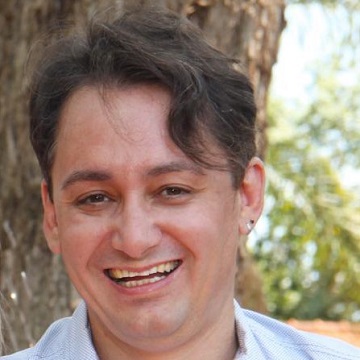Scientific Program
Keynote Session:
Title: Self-Healable Ultra-Stretchable Wearable Sensor Materials
Biography:
Evan K. Wujcik is currently an Assistant Professor in the Department of Chemical and Biological Engineering and an Adjunct Professor in the Department of Civil, Constructions, and Environmental Engineering at the University of Alabama (Tuscaloosa, AL, USA), where he directs the Materials Engineering and Nanosensor (MEAN) Laboratory. He obtained his Ph.D. in chemical and biomolecular engineering from The University of Akron (2013) and his MBA in 2011, M.S. in chemical engineering (2009), B.S. in applied mathematics (2010), and B.S. in chemical engineering (2008) from The University of Rhode Island. His research interests include stretchable electronics. advanced materials, polymers, fibers, electrospinning, and sensors.
Abstract:
Wearable strain sensors are essential for the realization of applications in the broad fields of remote healthcare monitoring, soft robots, immersive gaming, among many others. These flexible sensors should be comfortably adhered to skin and capable of monitoring human motions with high accuracy, as well as exhibiting excellent durability. However, it is challenging to develop electronic materials that possess the properties of skin. The presented skin-like electronic material exhibits ultrahigh stretchability, repeatable autonomous self-healing ability, quadratic response to strain, and linear response to flexion bending. This conductive polymer system, under ambient conditions, synergistically constructs a regenerative dynamic polymer complex crosslinked by hydrogen bonds and electrostatic interactions, which enables these unique properties. Sensitive strain-responsive mechanisms owing to the homogenous and viscoelastic nature provide omnidirectional tensile strain and bending deformations. Furthermore, this material is scalable and simple to process in an environmentally-friendly manner, paving the way for the next generation wearable sensors.
Title: Point-of-care assay for C-reactive protein using cavity enhanced absorption detection
Biography:
Zulfiqur has a BSc (Hons) Chemistry and PhD in instrumentation and analytical science from the University of Manchester. He in 1989 and has expertise in the development of smart miniaturised measurement systems. Zulfiqur has around 100 referred journals, book chapters and conference publications, with more than 3000 citations. He has coordinated numerous EC projects and most recently participated in the EC H2020 GateOne project. Zulfiqur currently has responsibility for the Healthcare Innovation Centre. He is on the Editorial Board for Micromachines and is member of the UK Research and Innovation Future Leaders Fellowships (UKRI FLF) Peer Review College.
Abstract:
We have previously demonstrated highly sensitive Cavity Enhanced Absorption (CEA) detection for low volume liquid assay [1-4]. In CEA, the high sensitivity recorded in the spectrometer is achieved through increasing the pathlength by locating the sample between two highly reflective dielectric mirrors. The light reflects between the two mirrors to form an optical cavity which magnifies the optical absorption effect. The CEA reader offers to potential of sensitivity approaching that of fluorescence but with lower reader cost - due to fewer optical elements – and the potential for being label-free. We have developed a point-of-care reader with Cavity Enhanced Absorption (CEA) detection and a well type fluidic cartridge for implementation of immunoassay. We describe proof of concept CEA point-of-care assay for C-reactive Protein (CRP) based on enzyme linked immunosorbent assay (ELISA). Sample cartridges are assembled containing a polylysine coated glass side, onto which CRP capture antibodies were immobilised. Sample is then added to the sample wells, incubated and washed. A biotinylated CRP detection antibody solution of 90ng/mL is added, incubated and washed, followed by addition of streptavidin-horseradish peroxidase which is again incubated and washed. The final step is the addition of TMB substrate followed by sulphuric acid which quenches the reaction. The intensity of the colour product formed in the reaction is measured by the CEA reader at 450nm and 540nm.
Title: A microfluidic-based sensor with a built-in probe for conformal mechanical measurements of different anatomical sites at the exterior surface of human Pectus Carinatum (PC) costal cartilage
Biography:
Jiayue Shen received her Ph.D. degree from Old Dominion University, Department of Aerospace and Mechanical Engineering in 2018. During the same year, she joined the College of Engineering, SUNY Polytechnic Institute as an Assistant Professor. Her research interests focus on flexible electrodes, microfluidic-based sensors, soft robots and related applications. She has published more than 16 journal papers and conference proceedings and has been serving as reviewers for various journals and international conferences. Additionally, she has been serving as a conference committee member of 2019 2nd International Conference on Smart Sensing and Intelligent System as well.
Abstract:
This study aims to measure the viscoelastic properties of different anatomical sites at the exterior surface of human Pectus Carinatum (PC) costal cartilage (CC) tissues via a microfluidic-based sensor, and determine whether the viscoelastic properties show a link with the anatomic sites and the cartilage length. Five CC segments from the 7th ~10th ribs are obtained from a 15yr-old PC patient. Using a testing protocol of multiple indentation-relaxation steps, four anatomical sites: anterior/posterior surfaces and superior/inferior borders are measured at locations of 6mm apart along the length of each CC segment. The instant indentation modulus and normalized relaxation amount are derived from the recorded viscoelastic response to quantify the elasticity and viscosity at each measured site of the CC segments, respectively. These CC segments are found to be stiffer and less viscous than healthy porcine CC. The normalized relaxation amount reveals a decreasing trend with the indentation depth in the range of 80µm~240µm, but becomes stabilized in the indentation range of 240µm~480µm for all the CC segments. Overall, the anterior surface is stiffer than the posterior surface, which is opposite to porcine CC and is possibly due to different gravitational forces acting on them. For all the CC segments, the instant indentation modulus and normalized relaxation amount both reveal a considerable, random variation among the four anatomical sites at the same location. However, the average instant indentation modulus and average normalized relaxation amount from the four sites at the same location both do not change much along the cartilage length, indicating that the rest anatomical sites might adjust to accommodate the change at one anatomical site. Only one of the segments show a decreasing trend of instant indentation modulus along the cartilage length and exhibits mild variation in elasticity and viscosity among the four sites and along the cartilage length.
Title: Nanomaterials for Electrochemical (Bio)Sensing: Electrochemical Synthesis
Biography:
Domenica Tonelli is full Professor of Analytical Chemistry at the Department of Industrial Chemistry “Toso Monrtanari” of Bologna University. She is the coordinator of the PhD School of Chemistry. She has published more than 220 papers in reputed journals and has been serving as an editorial board member of Nanomaterials.
Abstract:
In recent years, nanomaterials have attracted much attention to modify the surface of electrodes due to their intriguing physicochemical properties, which differ significantly from those displayed by the corresponding bulk materials. The realization of modified electrodes has been of crucial importance for the development of a new generation of electroanalytical devices with enhanced sensitivity and selectivity since the modifiers confer interesting properties to the support which can lead to a specific recognition and/or a pre-concentration of the analytes. Among the methods suitable to modify a conductive surface, electrodeposition displays several advantages, in terms of adhesion of the modifier and rapidity of the modification; furthermore parameters such as current density, applied potential, duration of the synthesis, electrode material, presence or absence of an additive play a key role in determining the shape and size of the resulting nanostructures. As an example, Figure 1 shows the SEM micrographs obtained for Pt nanoparticles (NPs) electrodeposited on GC and graphite, in the optimized conditions, both in the absence and in the presence of iodide . As already observed by El-Deab for Au nanoparticles deposition, the morphology is strongly affected by these factors; all the deposits appear with grey color and different contrasts, except for that obtained on GC in the presence of KI, which is bright, with more pronounced reflecting properties and behaving like a mirror surface.
This contribution aims to describe the most recent applications in the field of electrochemical (bio)sensors taking into account both inorganic and organic nanomaterials.
Title: Portable and wearable chemical sensors based on organic electrochemical transistor: from materials to devices
Biography:
Isacco Gualandi graduated in Industrial Chemistry summa cum laude in 2009 and he got his PhD degree in Chemical Sciences in 2013 at the Bologna University. After a period of post-doctoral fellowships at the Departments of Physics and Astronomy and Industrial Chemistry, he is now working as a researcher in Analytical Chemistry at Bologna University. His research activity focuses on the development of innovative electrochemical sensors based on both inorganic and organic materials.
Abstract:
The development of portable and/or wearable sensors is of high importance in several fields, such as point-of-care medical applications and environmental monitoring. Organic Electrochemical Transistors (OECTs) offer consistent advantages such as easy and cheap readout electronics, low supply voltage (usually < 1 V), low power operation (< 100 μW), biocompatibility, and ease of integration1. Moreover, the transistor configuration provides intrinsic amplification of the output signal and gives design freedom in terms of device geometries and substrates (flat/flexible). This contribution provides an overview on portable or/and wearable sensors based on OECTs to detect external dangerous agents for safety applications, or to monitor the concentration of specific compounds in bio-fluids for healthcare. The material science plays a key role in the development of non-invasive devices that can be embedded in every-day wearable gadgets because all elements should be realized with flexible, lightweight and safe components. Moreover, these materials must be able to convert the chemical signal in an electrical one with high sensitivity and selectivity, which are mandatory considering the operation in a complex medium containing many interfering compounds2. Finally, new composite organic semiconductors can be exploited to simplify the device architecture with relevant implications on the read-out electronics, adaptability to unconventional geometries and response time3. Thanks to these favourable features, fully-textile devices can be obtained by depositing the composite material directly onto a cotton yarn for real-time sweat monitoring.
Title: Organic Electrochemical Transistors: versatile platforms for Bioelectronics
Biography:
Federica Mariani is a post-doctoral research fellow working on bioelectronic devices at the Department of Industrial Chemistry, University of Bologna (Italy). During her studies, she spent some research stays at the Department of Bioelectronics (Ecole Nationale Supérieure des Mines de Saint-Etienne - France) in the group of Prof. R. M. Owens and in the group of Analytical Chemistry - Electroanalysis and Sensors of Prof. Wolfgang Schuhmann (Ruhr-Universität-Bochum - Germany).
Abstract:
In recent years, advancements in material research and technology have shed light on the disruptive impact of personalized diagnostic and therapeutic scenarios on the quality of life. Concomitantly, the need to bridge the gap between user-controlled electronics, such as sensors and actuators, and biology is evident. The design of effective interfaces allowing reliable interaction between electronics and biological entities is the ambitious purpose of Bioelectronics. Due to the mechanical mismatch between abiotic hardware components and living, water-rich systems and the fundamental discrepancy in the nature of charge transport, the efficient transduction of the biological signal remains a major challenge. In this panorama, Organic electrochemical transistors (OECTs) are electrochemical devices that are gaining momentum thanks to the unique combination of soft electronic components and the transistor configuration. On one hand, the transducing materials are typically soft conducting polymers capable of mixed conduction, that is, they can detect ionic fluxes and convert the bio-signal into an electronic output (or vice versa). On the other hand, the device benefits from intrinsic signal amplification and design versatility, thus realizing a high signal to noise ratio and adapting to a variety of geometries and substrates. In this contribution, the potentiality of OECT-based smart platforms will be presented, with particular focus on the realization of novel electrochemical sensors and biosensors for bio-signals transduction and highly sensitive and selective detection of medically relevant analytes, such as neurotransmitters.
Title: Novel biosensor methods in SARS-CoV-2 diagnosis
Biography:
Ebru Saatçi has completed his PhD at 2005 from Middle East Technical University, Turkey, and Postdoctoral Studies from Analytical Chemistry Department, Lund University, Sweden. Her research area is electrochemical enzyme and immnunosensors. She has two patent applications for this kind of biosensor development. Ebru Saatçi has completed his PhD at 2005 from Middle East Technical University, Turkey, and Postdoctoral Studies from Analytical Chemistry Department, Lund University, Sweden. Her research area is electrochemical enzyme and immnunosensors. She has two patent applications for this kind of biosensor development.
Abstract:
The emergence of SARS-CoV-2, responsible for COVID-19 disease, has caused a substantial worldwide pandemic and has become a significant public health problem. World Health Organization (WHO) has declared COVID-19 as a devastating health emergency for all countries. Public health officials continue to monitor the situation closely to control this new virus-related outbreak. In order to continue to manage this pandemic, a fast and sensitive diagnosis of COVID-19 is attempted. Emerging tests have become an essential part of the management of the COVID-19 crisis. In this webinar, current methods and biosensor-based methods will be given in methodic details.
Oral Session 1:
- Nanoelectronic Biosensors | Lab-on-a-chip and multiplexed sensors | Microfluidics and immobilisation technology
Title: Label-free Capacitive Biosensors
Biography:
Paulo R. Bueno has authored more than 170 papers, holds six licensed patents, and is one of the founders of Osler Diagnostics in the U.K. Some of his research projects have received awards from the Royal Society (including the Brian Mercer Feasibility and Newton Advanced Fellowship awards). He was endorsed as an exceptional talent in Physical Chemistry by the Royal Society. He is Fellow of Royal Society of Chemistry, and an invited member of the American Chemical Society. Dr. Bueno is also a member of other scientific societies, among them the Electrochemical Society and the International Society of Electrochemistry.Â
Abstract:
Title: Chronopotentiometric in vivo bioassay by using skin tattoo wearable diagnostic sensing smartphone analyzer
Biography:
Will update soon.
Abstract:
Analytical in vivo diagnostics are require of the expensive instrumental systems such as highly sensitive x-ray imagination amplifier, sophistic NMR spectrometry, Mass spectroscopy and other separation chromatographic circuits demand. However, in this study, simplified electrochemical in vio and vitro chrono potentiometric bio assay was developed by using skin tattoo diagnostic sensors and wearable smartphone analyzer. Here of in vivo tattoo skin sensors were made by with printing ink painting paste of natural plant fibers. Which ink solutions used as an absorbable muscle stimulation enhancer. Coated film thickness was 0.5 ~ 3 mm paste working, counter and reference electrode, did not interfere with any muscle activity. Which diagnostic scanning potential windows was the redox to -2.0 V ~ 2.0 V cyclic anodic and cathodic. The amplification rate was in the range of 1.0×10-3 to 1.0×10-9A used on this conditions, chronopotentiometric redox stripping, cyclic vital current was obtained at real time on the skin muscle tissue, such as pulse rate, respiratory rate, body temperature and other in vivo neuro diagnostics so on. Which optimal variables are available for WiFi tele transmission and be used for remote human smartphone interfaced diagnostic telemetric controls. Results of final para conditions were determined to be capable of more sensitive detection than other common methods.
Title: Effect of Cobalt Catalyst Confinement in Carbon Nanotubes Support on Fischer-Tropsch Synthesis Performance
Biography:
Omid Akbarzadeh is working with Nanotechnology and Catalysis Research Centre since 2016. His main research area is heterogeneous catalysis and catalytic reaction engineering. He has spent 10 years in academic-industrial projects as a research officer and post-doctoral. Omid has worked 5 years in the oil and gas industry as a chemical engineer. He developed advance smart catalysts especially for oil and gas industries. Omid has contributed to two PETRONAS Research Sdn Bhd industrial catalyst projects and worked on international Airbus R&D project in NANOCAT. Currently, he is the PI of graphene catalyst project in Hokkaido University in Japan, project member of FRGS grant in UTP and assigned to the NANOCAT center project. Dr. Omid was the Chairman, keynote speaker and organizing committee of many international conferences. He is currently supervisor of a few postgraduate students. He has published many ISI papers; book chapters and has two approved and granted patents. Also, he has hands-on experience and passed several pieces of training on handling different types of equipment which are being widely used for material synthesis, characterization and performance evaluation. He is in close collaboration with other departments, government agencies and universities around the world. He is visiting researcher of Jiangsu University China and Hokkaido University Japan. He is member of the society of petroleum engineers (SPE) and Senior Member of Hong Kong Chemical, Biological & Environmental Engineering Society. Omid awarded full fellowship from UTP during Ph.D and were involved for lab demonstrator and teaching in the different courses of chemical engineering. He awarded Silver Medal in 27th International Invention & Innovation Exhibition (ITEX 2016), Kuala Lumpur Convention Center in Malaysia and Silver Medal of Post Graduate Research Project in 35th Science & Engineering Design Exhibition (SEDEX 35).
Abstract:
Pre-treating the multi-walled carbon nanotubes (CNTs) support by refluxing in 35 vol% nitric acid followed by heating at the temperature of 600 to 900 °C resulted in the formation of defects on the CNTs. Increasing the temperature of the pre-treatment of the CNTs from 600 °C to 900 °C, enhanced the fraction of cobalt-oxide nanoparticles encapsulated in the channels of CNTs from 31% to 70%. The performance of Co/CNTs in Fischer-Tropsch synthesis (FTS) was evaluated in a fixed-bed micro-reactor at a temperature of 240 °C and a pressure of 2.0 MPa. The highest CO conversion obtained over Co/CNTs.A.900 was 59% and it dropped by 3% after 130 h of time-on-stream. However, maximum CO conversion using Co/CNTs.A.600 catalysts was 28% and it decreased rapidly by about 54% after 130 h of time-on-stream. These findings show that the combined acid and thermal pre-treatment of CNTs support at 900 °C has improved the stability and activity of the Co/CNTs catalyst in FTS.
Title: Sensor integration in a brain blood barrier on a chip
Biography:
Monica Mir received the Degree in Chemistry in 1998 and in 2006 her PhD in biotechnology. She realized different predoctoral stages in Greece and UK. From 2007, she held a postdoctoral position in Max Planck Institute, Germany. Since 2008, she joins the Institute for Bioengineering of Catalonia (IBEC), as Senior CIBER researcher, combined with her teaching as associate professor in the University of Barcelona. Along her carrier she was managing European, National and industrial research projects, supervising PhD students and collaborating in congresses as scientific committee. Her main interests are electrochemical biosensor, point-of-care technologies, implantable-sensors and organ-on-a-chip for biomedical applications.
Abstract:
Alzheimer’s disease (AD) is a chronic neurodegenerative disorder characterized by a progressive loss of cognitive capacity and memory. AD is mainly associated to the accumulation of toxic aggregates of amyloid β peptide (Aβ) in the brain which produce oxidative stress and neurotoxicity [1]. In the last years, multiple efforts have been performed in order to develop new molecules for AD’s treatment based on the disaggregation of Aβ cumulates [2]. However, most of them do not reach the action site due the strict permeability in the brain by the blood brain barrier (BBB). It is very relevant for drug testing in AD and other neurodegenerative diseases to have a platform that can mimic the permeability of BBB in healthy people and AD patients where the BBB permeability is increasing along the diseases. The present study investigated an animal free technology of permeability BBB tuning and sensing integrated in a BBB-on-a-chip. Two microfluidic channels interconnected through closely fabricated stacks to recreate barriers will be cell cultured in one channel with pericytes and astrocytes and another channel with endothelial cells to construct the BBB. The microfluidic chip is fabricated with integrated electrodes for Transepithelial /transendothelial electrical resistance measurements to monitor the permeability of the fabricated BBB and with electrodes under the barrier to tune the permeability. This platform is an excellent platform to study neurodegenerative diseases and drug testing.
Title: IoTRing: A Trusted bio-inspired Sensing Approach
Biography:
Will update soon.
Abstract:
A PHP Error was encountered
Severity: 8192
Message: trim(): Passing null to parameter #1 ($string) of type string is deprecated
Filename: pastconference/past-program-schedule.php
Line Number: 354
Backtrace:
File: /efsdata/meetingsint-com/application/views/pastconference/past-program-schedule.php
Line: 354
Function: trim
File: /efsdata/meetingsint-com/application/controllers/Pastconference.php
Line: 128
Function: view
File: /efsdata/meetingsint-com/index.php
Line: 317
Function: require_once
Title: Optimizing Nanobiosensor systems
Biography:
Accomplished Innovator: over 20 patents (granted & applied), vast systems experience in analog, digital, low power, mechanical, ultra low power systems for battery powered wearable / IoT / robotics.
And also an exceptional Leader / Team Builder: recruited, mentored, and directed diverse engineering teams (>50), managed /collaborated business operations in U.S., EU, and Asia.
Proven Track Record: pioneered world’s first +/- 50 ppm pMEMS stacked die oscillator, engineered world-class temperature sensors, and much more.
Entrepreneur: founded Andigilog and Salsa Semiconductor.
Passionate about bringing new technology and products to market.
Abstract:
Will update soon..
Title: Below ppm ammonia gas detection using and innovative polyaniline based conductometric sensor
Biography:
Iulia Antohe received a Master degree in Materials Science in 2011 from University of Bucharest, Romania and a PhD award in Bioscience Engineering in 2016 from University of Leuven, Belgium. Since 2018 she is a Scientific Researcher 3rd degree within the National Institute for Laser, Plasma and Radiation Physics (INFLPR), Romania. She acquired knowledge in the field of physics and technology of nanostructured materials, thin film bio-/functionalization, as well as abilities in handling various thin film deposition methods and different structural, morphological, optical and electrical characterization techniques of nanomaterials. Her research interests include bio-nanotechnology, plasmonic biosensing and bioassay development.
Abstract:
The demand of ammonia sensing systems is increasing because of its high toxicity even in small concentrations. Moreover, ammonia sensors have a wide range of applications in agricultural, industrial, and biological applications such as in the production of fertilizers, explosives, textiles, plastics and food processing. Therefore, the development of reversible and highly sensitive ammonia sensor is highly required. In this work, a conductometric ammonia gas sensor has been designed and fabricated using polyaniline (PANI) as sensing element. The sensor is fabricated by coating an alumina substrate with a platinum film using a magnetron sputtering technique and an in-house fabricated shadow mask, while the conductive polyaniline layer was synthetized using a relatively novel electroless polymerization method. Structural and morphological characterizations of PANI layer were carried out using X-Ray Diffractometer (XRD) and Scanning Electron Microscope (SEM), respectively. The detection of ammonia gas has been carried out at room temperature and using an in-house built setup for testing electrical gas sensors. The proposed sensor is highly sensitive for concentrations of ammonia gas below 1ppm and has small response as well as recovery time.
Keynote Session:
Title: Imaging Cellular Forces with Nucleic Acid-based Tension Sensors
Biography:
Dr. Xuefeng Wang is an assistant professor in the department of Physics and Astronomy at Iowa State University since 2015. He obtained Ph.D. of Physics from Purdue University in 2009 and worked as a postdoctoral researcher at University of Illinois at Urbana-Champaign in 2010-2015. He was trained as a biophysicist and with specialty in single molecule detection and imaging. Currently, with the support from NIH and NSF funds, Wang’s lab develops DNA-based biosensors for cellular force imaging in live cells and DNase detection on the cell membrane. His lab studies the role of integrin tensions in cell adhesion and migration by imaging cellular forces with single molecule sensitivity and 50 nm spatial resolution.
Abstract:
Integrin-transmitted cellular forces play critical roles in many cellular functions including cell migration and platelet-mediated hemostasis. Conventional cell traction force microscopy suffers from the low spatial resolution and high demand for assay preparation and data processing. Here we developed integrative tension sensor (ITS) [1]which converts force to fluorescence, therefore enabling cellular force mapping directly by fluorescence imaging. ITS is based on nucleic acid duplexes such as DNA and PNA (peptide nucleic acid) that are decorated with dye, quencher, ligand and biotin. Immobilized on a surface, the tension sensors can be ruptured by cellular forces, freeing dyes from quenching and hence reporting cellular force by fluorescence. With ITS, we mapped integrin-transmitted platelet force at 0.4 µm resolution and calibrated the integrin tension levels required by platelet adhesion and contraction. Based on ITS, we further developed super-resolution cellular force microscopy, termed Cellular Force Nanoscopy (CFN), to image cellular force with 50 nm spatial resolution. CFN was applied to study the role of integrin tensions in cell migration. In the fast migrating keratocytes, CFN revealed three regimes of integrin tensions: high-level integrin tensions (>54 pN) at cell rear edge mediating cell retraction, low-level tensions (12-54 pN) at the very front edge mediating cell protrusion, and low-level tensions under lamellipodia mediating cell contraction. Overall, ITS and the associated CFN provide a powerful technique for measuring and mapping integrin tensions in platelets, keratocytes and many other adherent cells with high resolution and sensitivity, holding great potential in the study of cell mechanobiology.
Title: Epigenetic leukocyte subtyping using digital droplet PCR for hematological diagnostics
Biography:
Lidija Malic is a Research Officer leading the Precision Diagnostics team at the Bio-Analytical-Micro-Nano-Devices Section, Life Sciences Division of the National Research Council of Canada. She also holds an Adjunct Professorship at the Biomedical Engineering Department at McGill University. Her research is focused on the development of electrowetting, centrifugal and pressure-driven microfluidic devices in polymer materials for applications in medical diagnosis, food and water safety, single cell analytics, and space related applications. Lidija holds a PhD from the department of Biomedical Engineering, McGill University in Montreal, Canada and an MBA from John Molson School of Business in Montreal, Canada.
Abstract:
Analysis of the composition of white blood cells is among the most frequently requested laboratory tests in hematological diagnostics. Differential leukocyte count serves as indicator for a spectrum of diseases including infection, inflammation, anemia, and leukemia, and is under investigation as early prognostic biomarker for several diseases. Epigenetic markers have recently emerged as powerful analytic tools for the study of phenotypic variations. This has led to the investigation of cell-lineage DNA methylation patterns that correlate with human leukocyte populations, allowing precise quantification of white blood cell (WBC) subset.1,2 The methods of DNA methylation analysis, however, often require costly and complex techniques involving genome sequencing or loci-specific quantitative PCR (qPCR). Herein, a thermoplastic elastomer droplet microfluidic device is presented and employed for methylation specific digital droplet PCR. The technology has been used to delineate specific leukocyte subtypes based on cell-lineage DNA methylation patterns.3 Bisulfite-treated DNA from blood samples is encapsulated in droplets with ddPCR reagents containing primers and TaqMan fluorescent probes specific for CpG loci correlated with WBC sub-population types. The multiplex approach allows the interrogation of many CpG loci without the need for separate ddPCR reactions, allowing more accurate parametric determination of WBC sub-populations using epigenetic analysis of methylation sites. The presented method achieves multiplex detection of various methylation sites within a single droplet, while promoting customizability and cost-effectiveness, which are prerequisites for translation into clinical diagnostics.
Oral Session 1:
- Nucleic acid-based sensors and Aptasensors | Whole cell- and organ-based biosensors | Enzyme-based biosensors
Title: Near field non-invasive electrophysiology of retrotrapezoid nucleus using amperometric cation sensor
Biography:
Sujasha Gupta has completed his PhD in Mechanical Engineering at the age of 29 years from The Ohio State University, United States. Her work focusses on developing neural interfacing devices for real-time monitoring of nerve health. She is an academic achievement award recipient, which was awarded during her Masters at University of Florida.
Abstract:
Central chemoreception is the process whereby the brainstem senses blood gas levels and adjusts homeostatic functions such as breathing and cardiovascular tone accordingly. Rodent evidence suggests that the retrotrapezoid nucleus (RTN) is a master regulator of central chemoreception through direct sensation of acidosis induced by CO2 levels1, 2. The oscillatory dynamics caused by pH changes as sensed by the RTN and its relationship to the fluctuations in cation flux is not clearly understood due to the current limitations of electrophysiology tools and this article presents our investigations to address this need. A cation selective sensor fabricated from polypyrrole doped with dodecyl benzenesulfonate is placed over RTN of an ex-vivo en bloc brain and cation concentration changes above the RTN is measured due to changes in externally imposed basal pH. The novelty of this technique lies in its feasibility to detect cation fluxes from the cells in the RTN region without having to access either sides of the cell membrane. Owing to the placement of the sensor in close proximity to the tissue, we refer to this technique as near-field electrophysiology3. It is observed that decreasing pH in the physiological range (7.4–7.2) results in a significant increase in cation concentration in the vicinity of RTN with a median value of ~5 μM. The utilization of such quantifiable measurement techniques to detect sub-threshold brain activity may help provide a platform for future neural network architectures. Findings from this paper present a quantifiable, sensitive, and robust electrophysiology technique with minimal damage to the underlying tissue.
Title: Aptasensors for detection of small molecules
Biography:
Abstract:
Oral Session 2:
- Printed biosensors and microfabrication | Wireless Sensor Networks
Title: Fabrication of new biosensor based on gold nanoparticles and chitosan matrix for selective detection of chlorophenol and nitrophenol
Biography:
Hicham Meskher has completed his environmental engineering studies at the age of 24 years from Algiers National Polytechnic School (ENP Alger), Algeria. He is a PhD student at Kasdi Merbah University in Ouargla, Algeria. He has published one paper about water scarcity in the Moroccan Atlas Mountains and has participated in several related conferences and summits in MENA region and Turkey.
Abstract:
It is highly recommended to design and manufacture cost effective analytical tools to monitor harmful organic pollutants in our environment. Phenols are a class of widely used hazardous and dangerous organic compounds that have serious effects on human health and the environment. This present study reports an inexpensive and robust, sensitive and selective electrochemical biosensor for chlorophenol and nitrophenol detection, both of pollutants are electroactive compounds which may be oxidized or reduced by electrocatalysts (Wang et all, 2018). We propose a novel biosensor architecture based on gold nanoparticles (AuNPs) and chitosan matrix. Here, chitosan and gold nanoparticles were used as the bionanocomposite matrix to immobilize tyrosinase enzyme in the biosensor construction using glassy carbon electrode (GCE). The electron transfer rate increased by the bio-catalytic activity of gold nanoparticles (Mohtar et al, 2018) and possession of the porous morphology of chitosan (Chakraborty et al, 2019) provided excellent entrapment of the tyrosinase enzyme. The proposed electrode (Tyr/AuNPs/Chit/GCE) is expected to achieve a significant electrochemical behavior and electroanalytical performances compared to bare electrode (sensitivity and selectivity, stability and reproducibility). In addition, the current response is proportional to the concentration of chlorophenol and nitrophenol which attributed to the reduction of o-quinone formed on the surface of the electrode. As a result, Tyr/AuNPs/Chit/GCE biosensor is ready to evaluate a real sample of water.
Title: Molecular imprinting polymers electrochemical sensor for highly sensitive detection of carcinoma embryonic antigen
Biography:
Fatah Benmoussa has completed his chemical engineering studies in the age of 24 years from the University Of Kasdi Merbah Ouargla (UKMO),Algeria. He is a PhD student at Kasdi Merbah University in Ouargla ,Algeria . He has published two papers about the asymmetric reduction of acetophenone.





















